click on the home button to go to the home page
|
The Industrial Era 1989-1990 The Fourth generation of computers starts approximately
in this era. These computers are characterized by fully electronic
and programmable models. ICs are built which contain more than 500.000
components. With this step the FOURTH GENERATION of computers started |
pre history | antiquity | pre industrial era | industrial era
1947 - 1950
- 1952 - 1955 - 1958
- 1961 - 1963 - 1965
- 1969 - 1970 - 1972
- 1974 - 1976
1978 - 1980 -
1981 - 1982 - 1984 - 1986
- 1989 - 1991
- 1993 - 1994 - 1996
- 2000 - 2002
| Related Articles |
| Apple company |
| Related Resources |
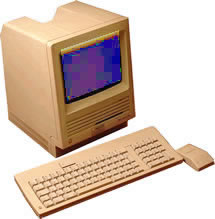
Apple MacIntosh SE/30 (7)
![]() Apple
introduces one of its best Mac Intosh products ever: MacIntosh SE /30. A built-in
hard drive with 128Kb RAM a 1.4Mb floppy that can read PC disks and is powered
with a Motorola 60030 CPU. The machine keeps a good price on the second hand
market because it is much in demand with business people
Apple
introduces one of its best Mac Intosh products ever: MacIntosh SE /30. A built-in
hard drive with 128Kb RAM a 1.4Mb floppy that can read PC disks and is powered
with a Motorola 60030 CPU. The machine keeps a good price on the second hand
market because it is much in demand with business people
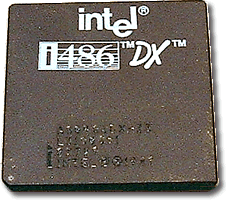
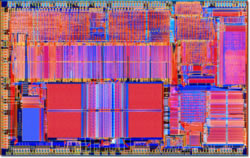
housing and die Intel 486
![]() in
April this year INTEL continues its development of the 80386 with the 80486.
In fact it is a 386 but with a cache of 32 Kb and a coprocessor integrated in
a single chip. In the coming two or three years the chip will not completely
be bug free, a common trait of the industry. The processor contains 1.2 million
transistors and operates at 20 MIPS.
in
April this year INTEL continues its development of the 80386 with the 80486.
In fact it is a 386 but with a cache of 32 Kb and a coprocessor integrated in
a single chip. In the coming two or three years the chip will not completely
be bug free, a common trait of the industry. The processor contains 1.2 million
transistors and operates at 20 MIPS.
![]() ARPANET
turned off (August)
ARPANET
turned off (August)
With the successful introduction of TCP/IP, which allows different computer
networks to communicate with each other, ARPANET is becoming obsolete, and ARPA
decides to decommission the network. By the summer of 1989, all of ARPANET's
sites are transferred to the faster NSFNET, and ARPANET is turned off for good.
(6)
![]() Quantum Computer
Services in Vienna, Virginia USA, names online service America Online (October)
Quantum Computer
Services in Vienna, Virginia USA, names online service America Online (October)
The company has developed a network with Apple, called AppleLink, but when the
two companies part ways, Quantum changes the name of the service to America
Online. Later, the entire company becomes America Online. (6)
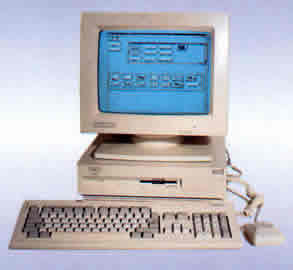 |
|
|
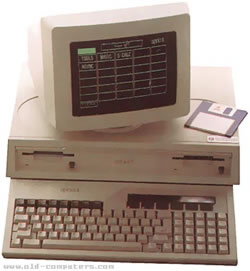 |
![]() Maxell
is marketing the first 5.25" 10 Mb floppy discs developed by IBM. The disk
has a slow (80 ms) access time but still quicker than a regular 8" disk
with 150 milliseconds.
Maxell
is marketing the first 5.25" 10 Mb floppy discs developed by IBM. The disk
has a slow (80 ms) access time but still quicker than a regular 8" disk
with 150 milliseconds.
![]() All modern
computers are now standard equipped with VGA monitors and cards, initially with
256 Kb but soon 512 Kb becomes the norm. Through this improvement in graphics
the development and acceptance of drawing programs are greatly stimulated. ACAD
and ORCAD are some of the programs which have a full development environment
(Computer Aided Design) which can now be used on a PC. Before only highly specialized
and very expensive (> 150,000 U$) machines were capable of doing that.
All modern
computers are now standard equipped with VGA monitors and cards, initially with
256 Kb but soon 512 Kb becomes the norm. Through this improvement in graphics
the development and acceptance of drawing programs are greatly stimulated. ACAD
and ORCAD are some of the programs which have a full development environment
(Computer Aided Design) which can now be used on a PC. Before only highly specialized
and very expensive (> 150,000 U$) machines were capable of doing that.
![]() Commodore
is the first to bring the CD-I (compact disc interactive) to the market. The
principle was introduced a couple years ago by Rank Xerox, but Commodore succeeded
to be the first to bring this product commercially on the market.
Commodore
is the first to bring the CD-I (compact disc interactive) to the market. The
principle was introduced a couple years ago by Rank Xerox, but Commodore succeeded
to be the first to bring this product commercially on the market.
The system is based on the interaction between the hard- and soft ware. The
hardware consists of a CD on which both the program and data are. By means of
a mouse/controller one can react interactively on a game. Hence the end
of a game is not always the same. For educational purposes one can by pointing
to a picture or an item on the screen obtain more information. E.g. by clicking
on a painting one can get more information of the painter. The idea of interactive
media is based on the HyperCard principle: "links" from a subject
to other information.
![]() Tim
Berners Lee didn't invent hypertext,
but he invents software for the World Wide Web. HyperText Markup Language, also
known as HTML
Tim
Berners Lee didn't invent hypertext,
but he invents software for the World Wide Web. HyperText Markup Language, also
known as HTML
 |
The mild-mannered Berners-Lee is working at CERN, a high-energy physics lab in Switzerland. He has already written a few database programs to store information via random links, but this was only for his personal use. Then the idea came to him -Click!- to create a hypertext structure that would span the globe via the Internet, accessible to anyone with a mouse.... (4)
|
![]() In 1990 the
World Wide Web is officially born when Tim Berners-Lee of the physics laboratory
in Geneva developed the HTML and WWW software for it.
In 1990 the
World Wide Web is officially born when Tim Berners-Lee of the physics laboratory
in Geneva developed the HTML and WWW software for it.
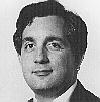 |
|
![]() First Internet
service provider: The World. It becomes the first commercial provider of dial-up
Internet access. (6)
First Internet
service provider: The World. It becomes the first commercial provider of dial-up
Internet access. (6)
![]() Zenith, Compaq,
Olivetti and ALR launch, before IBM, computers of the Intel
486 series on the market. Compaq is the most expensive (US$ 27,000)
Zenith, Compaq,
Olivetti and ALR launch, before IBM, computers of the Intel
486 series on the market. Compaq is the most expensive (US$ 27,000)
![]() The 20 Mb 5.25"
floppy disc is for sale on a limited scale.
The 20 Mb 5.25"
floppy disc is for sale on a limited scale.
|
|
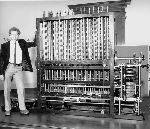 |
![]() Window 3.0 has
become a GUI (Graphical User Interface) which adapts automatically to
the built-in CPU and memory (RAM). Special versions for e.g. the 80286 and 80386
are not necessary anymore.
Window 3.0 has
become a GUI (Graphical User Interface) which adapts automatically to
the built-in CPU and memory (RAM). Special versions for e.g. the 80286 and 80386
are not necessary anymore.

window 3.01 screenshot
Microsoft and IBM have a problem because of the marketing of Windows 3.0 by Microsoft. In the opinion of IBM, Windows 3.0 is competing with the development and acceptance of the OS/2 system. MS maintains that this is not the case. However, Windows 3.0 is a serious competitor for OS/2. Window 3.0 is far closer to the demands of the user than OS/2 ever will be in the coming years. For this reason the Management of IBM thinks to loose their market share through in their eyes unfair competition by MS who was involved with IBM in the development of OS/2.
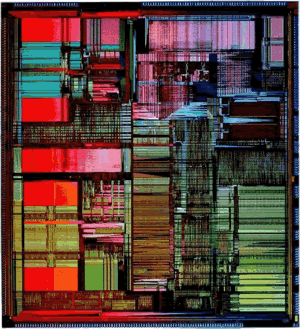 |
|
![]() In the same
month IBM introduces the model 90 (80486 CPU), a powerful machine which is developed
to support office automatization within a network surrounding. Special for the
model 90 is that it has the so-called open CPU architecture. This means cards
can be replaced/added which makes it possible to equip the machine with e.g.
a parallel processor. Also exchanging the CPU card with another (e.g. a 586)
is now possible.
In the same
month IBM introduces the model 90 (80486 CPU), a powerful machine which is developed
to support office automatization within a network surrounding. Special for the
model 90 is that it has the so-called open CPU architecture. This means cards
can be replaced/added which makes it possible to equip the machine with e.g.
a parallel processor. Also exchanging the CPU card with another (e.g. a 586)
is now possible.
Other manufacturers will follow with other 'high-end' (read more expensive) models.
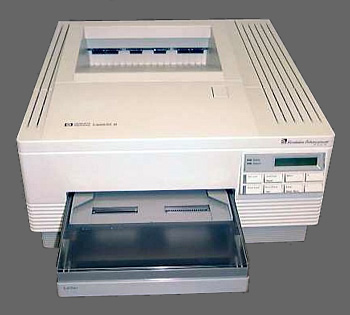 |
In the mean time the HP printer technology has become the world standard. There is almost no printer available which can not emulate the HP II printer. |
![]()
| Last Updated on June 16, 2004 | For suggestions please mail the editor in chief |
Footnotes & References
| 4 | LAMONT WOOD |
| 6 | www.historychannel.com/timeline |
| 7 | Machine domated to the museum by Jeen de Jong, picture C. Robat |